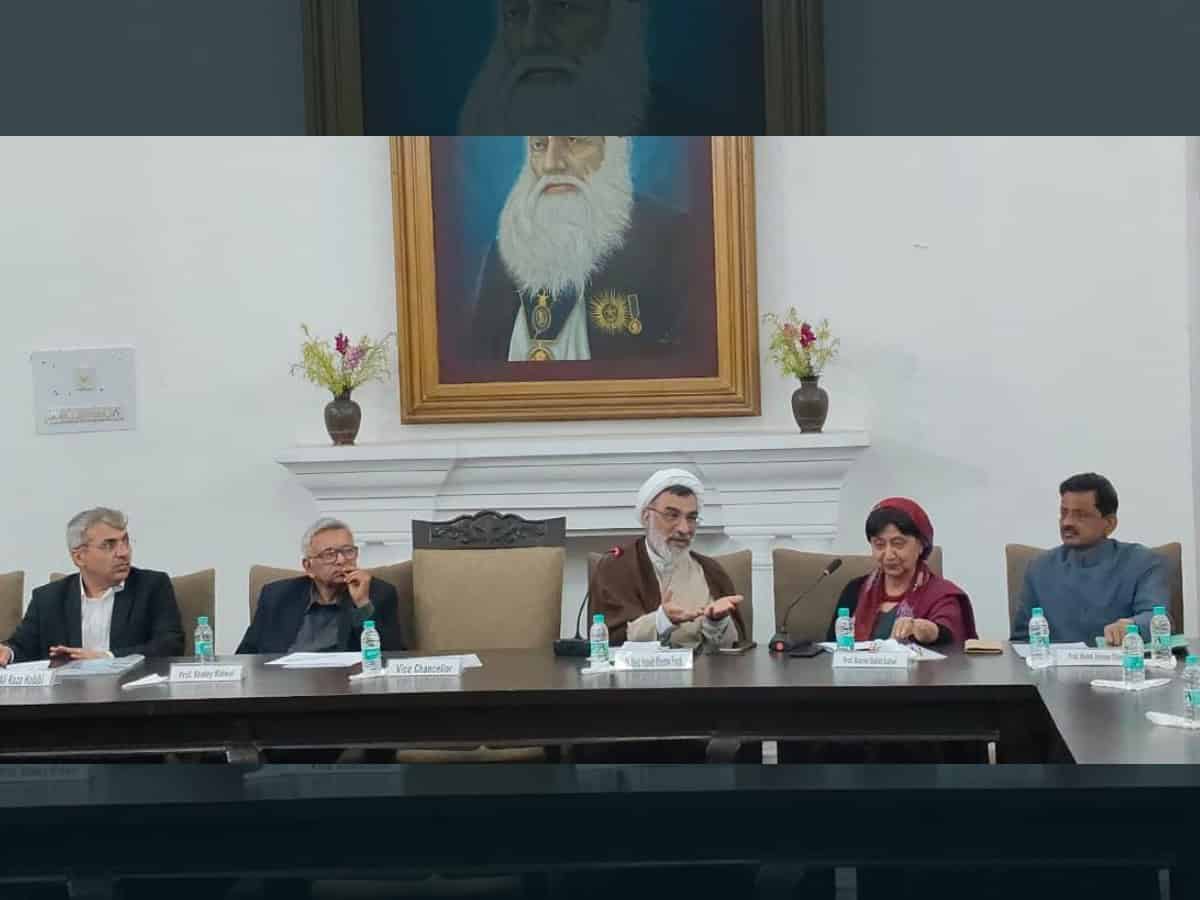
Aligarh: The Institute of Persian Research at Aligarh Muslim University (AMU) organized a special lecture on “Relations Between India and Iran” under the aegis of Sir Syed Academy.
Professor Shafey Kidwai presided over the session. Dr. Abdolhossein Khosropanah, Secretary of the Supreme Council for Cultural Revolution, Iran was the chief guest, while Prof Alireza Habibi and Prof Mohammad Rizwan Khan, Dean of the Faculty of Arts, participated as guests of honour.
Dr Abdolhossein Khosropanah delivered an insightful discourse on India-Iran relations, elaborating on the concept of wisdom and its four categories. He emphasized the centuries-old connections between the two nations, evident in Persian inscriptions found across India. He cited numerous books on the subject, including one by Jawaharlal Nehru, and mentioned Shahnameh, in which Firdausi frequently refers to India.
Dr Khosropanah expressed optimism that these ties have remained intact despite the passage of centuries and stressed that wisdom and intellectual engagement are key to further strengthening them. He emphasized that wisdom is rooted in reason, which requires a pure and lawful livelihood to nurture good qualities that foster India-Iran relations.
Dr Alireza Habibi described the two nations as two branches of the same tree. He highlighted various scholarly works on their shared cultural and civilizational heritage and emphasized that contemporary Persian literature also reflects this historical bond. He noted that storytelling in Iran was greatly influenced by the Indian classic Panchatantra and urged Persian scholars and students to dedicate efforts to researching Indo-Iranian literature.
Persian, a living language
Prof Mohammad Rizwan Khan reiterated his interest in Persian as a living language and elaborated on its literary significance. He spoke at length about theorising humanities while stressing that literature should be the core of all studies. Rather than focusing on theories, it is important to revitalize the appreciation of literature in a focused and rooted manner. He talked of various new trends in humanities like environmental humanities, health humanities, blue humanities and digital humanities.
Prof Azarmi Dukht Safavi, the founding director and advisor of the Institute of Persian Research, introduced the distinguished guests. She noted that Dr. Abdolhossein Khosropanah holds the chancellorship of all Iranian universities and oversees five ministries. She also introduced Dr. Alireza Habibi, a professor at Allameh Tabataba’i University, Tehran, and Deputy Director of Iran’s Cultural Heritage Department.
Prof Safavi presented an Urdu and English translation of Dr. Khosropanah’s lecture.
Prof Zakiya Siddiqui expressed gratitude to Dr Khosropanah for his enlightening lecture and acknowledged the presence of young women and students in the audience, encouraging them to follow in the footsteps of Prof Safavi as a role model.
Kidwai talks of folk tales
In his presidential address, Professor Shafey Kidwai, Director, Sir Syed Academy shed light on ancient Indo-Iranian folktales, emphasizing that they were the earliest links between the two nations. He pointed out that modern writers and poets continue to highlight this shared heritage in their works, citing Sadegh Hedayat’s novels, which have been translated into multiple languages. He encouraged further focus on contemporary Persian literature to sustain the Indo-Iranian cultural connection.
Earlier, welcoming the guest speakers, Prof Mohammad Usman Ghani, Director of the Institute of Persian Research and Chairman of the Department of Persian, provided insights into the history of ancient Persian civilization and the shared cultural and civilizational heritage of India and Iran. He highlighted that the ties between the two nations date back to the Aryan period and were further strengthened by translating Panchatantra into Pahlavi.
Role of Panchatantra
He underscored the cultural and historical similarities between India and Iran. He referenced historical figures such as Darius, who annexed Sindh into his empire without distinguishing between Indians and Iranians, and Nushirwan, who admired Bidpai’s wisdom. The influence of Persian scholars and artists became more profound during the Ghaznavid and Ghurid dynasties, and during the Delhi Sultanate, many significant Persian literary works were written. He remarked that the Mughal court was considered a second version of the Safavid court, where Persian flourished more than even in Isfahan.
After the event, gifts were exchanged, with Prof Mohammad Usman Ghani presenting publications from the Institute of Persian Research to Dr. Abdolhossein Khosropanah and Dr. Alireza Habibi.
Following the session, the visiting Iranian scholars met with AMU Vice-Chancellor Professor Naima Khatoon. They discussed various cultural, academic, and educational collaborations between AMU and other universities in Iran and India.
The programme concluded with a vote of thanks by Dr. Ehteshamuddin.



